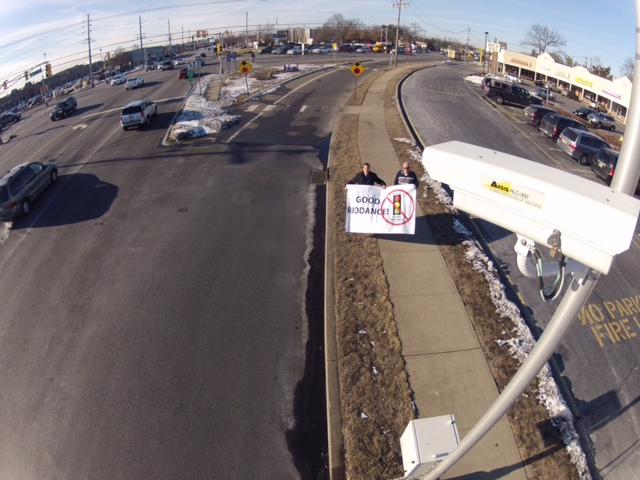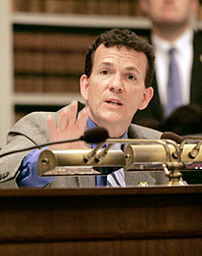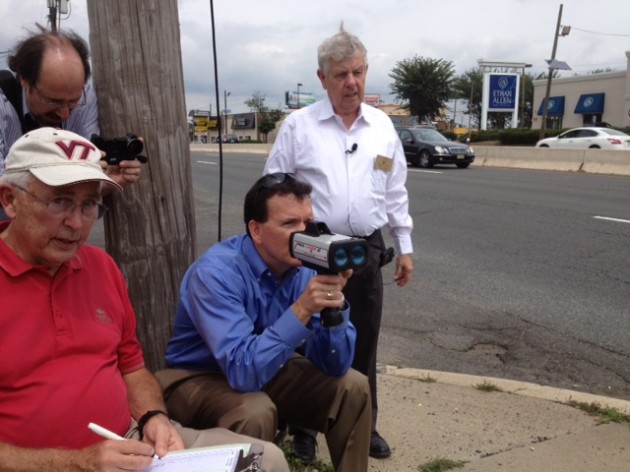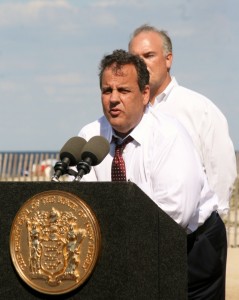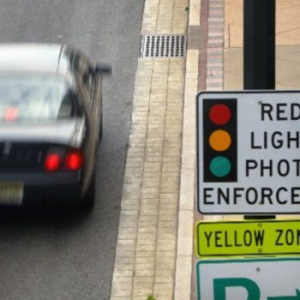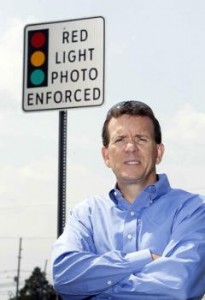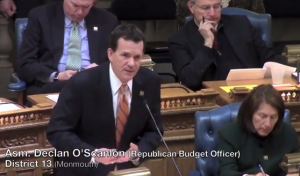O’Scanlon and Ducey Celebrate “Good Riddance” To Red Light Ripoffs
Assemblyman Declan O’Scanlon and Brick Mayor John Ducey celebrated the end of the Township’s red light camera program yesterday by posing for one last image for American Traffic Solutions’ computers in Arizona to process.
Fulfilling a campaign promise made during his race for mayor last fall, on February 6 Ducey announced the results of his study of Brick’s RLC results showing that the cameras actually increased traffic accidents over the three year program and refused to renew the contract of ATS, the Arizona company that administered the program and kept roughly half of the fine monies collected. The contract expired at midnight today.
O’Scanlon, New Jersey’s leading critic of the RLC program praised Ducey for protecting Brick’s motorists from the dangerous rippoffs and called on the leaders of the twenty-four New Jersey municipalities that still have the cameras to do the same thing: “One down, 24 to go!” O’Scanlon declared.
“This is a historic day on a number of fronts. Most obvious is the end of the program” said O’Scanlon. ”But perhaps more importantly we should today celebrate an elected official – Mayor John Ducey – who chose to simply do the right thing – rather than come up with any excuse to continue to steal from his constituents. I invite the other 24 mayors of towns in this program to follow Mayor Ducey’s lead.”
“Red light cameras do not reduce accidents of ANY KIND – the myth they reduce some types of accidents while increasing others is just that. Brick is a perfect example. Two out of three intersections saw dramatic increases in accidents – right angle crashes as well as rear-end accidents. The third intersection saw no change in right angle crashes and an increase in rear end crashes. Accident costs overall went up. All this while millions of dollars of fees went to the camera companies – most charged to people making right turns on red or for split second technical violations. The program was – I am happy to be able to use the past tense – a dismal failure.”
“When I was running for Mayor, one of the most frequent sources of frustrations of the people I spoke to was the red light cameras. I promised to review our red light camera program and remove them if that review didn’t convince me that they were making our roads safer,” said Mayor Ducey. “I have kept that promise. After conducting that review, I am not convinced that the benefit is safety and not revenue.”
The result of Ducey’s investigation into the Brick RLC program tell the story:
At all three Brick intersections with Red Light Camera systems in place, statistics compiled from Brick’s own police department show there has been no decrease in right angle accidents – the very accidents red light companies claim to prevent.
- Two of the Brick intersections, Rt 70/Chambersbridge Road and Brick Blvd/Chambersbridge Road, have been in operation for 3 and 4 years, respectively. Brick Blvd/Rt 70 has been in operation one full year.
- Rt. 70/Chambersbridge Road, after three years has seen increases in rear end accidents and a 400% increase in the more dangerous right angle accidents. (1 right angle crash pre-camera and 5 in the last full year).
- Rear end accidents at Route 70 and Chambersbridge Road also increased marginally after three full years of camera operation.
- Brick Blvd/Chambersbridge Road, after four years has seen rear end accidents at the intersection more than double, along with a 60% increase in the more serious right angle accidents. (7 rear-ends and 5 right angles pre-camera, 15 rear ends and 8 right angles in the last full year)
- The increased cost due to accidents, using the Department of Transportation’s own cost-benefit analysis metrics for red light camera intersections has been $86,400 due to increased accidents and severity for right angle crashes at Rt. 70/Chambersbridge Road. ($7,400 pre-camera to $93,800 in the current year)
- The increased costs due to accidents, using the Department of Transportation’s own cost-benefit analysis metrics for red light camera intersections has been $166,000 due to increased accidents and severity for all accidents at BrickBlvd/Chambersbridge Road. ($166k in the pre-camera year to $329k in the last full year of data)
- Increased citations do not equal an increase in safety at the intersection. While Rt. 70/Chambersbridge Road’s citation rate has decreased by about a third per month since the beginning of the program, there has been an increase in accidents over that period. (~750 citations per month during the first year to ~500 citations per month currently)
- Brick Blvd/Chambersbridge Road’s accidents have more than doubled, yet citations are decreasing. This is more than likely from people avoiding the intersection entirely, or not turning right on red – not because the intersection is any safer.
O’Scanlon said that Brick’s experience with RLCs proves that not only are the cameras a revenue generating safety hazard, but that the companies selling the program to unwitting or greedy municipal officials routinely mislead those officials and the citizens they were elected to serve.
“The Brick experience also showed us direct evidence of the camera companies’ fraudulent practices. They actually tried to tell the Mayor the program was a success. They produced a report that purposefully, shamelessly, outrageously excluded data from two out of the three intersections in the program. They also tried to sell the Mayor on the value of the program based on the fact that it was stealing most of the revenue generated from folks outside of Brick. Lastly they again tried to redefine success of the program in terms of the number of violations written – rather than in reductions in accidents. Why? Because you can easily have reductions in citations and an INCREASE in accidents. Accident rates are the only metric that counts!”
“These cameras have a history of increasing accidents – certainly not decreasing them – and the camera companies have a history of lying about those facts. Municipal officials have a history of choosing to passively fall prey to the camera companies’ misinformation campaigns so the officials can feel better about stealing from their constituents. Today we can say – in one municipality at least – not anymore.”
New Jersey’s RLC program is set to expire at the end of this year, unless reauthorized by the legislation.
